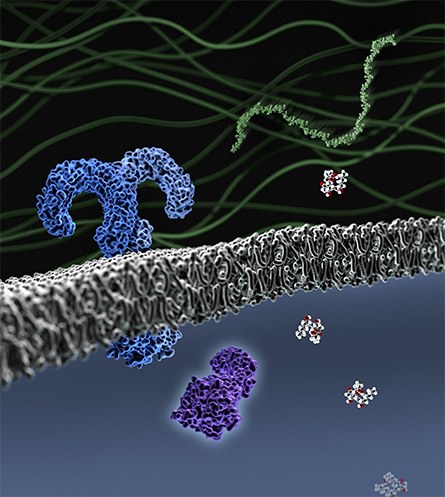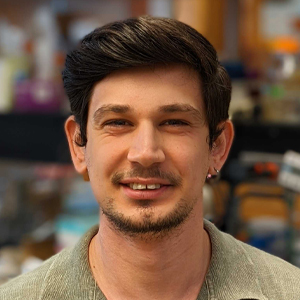From the journals: MCP
Effective washing for more membrane proteins. Shedding light on the omics of a model cell line. Read about papers on these topics recently published in the journal Molecular & Cellular Proteomics.
Effective washing for more membrane proteins

components (bottom).
Nutrient transport, cellular respiration and photosynthesis, cell adhesion, and signal transduction are all essential for maintaining cellular homeostasis. Among the biological molecules that carry out these processes, membrane proteins play major roles. Thus, the more we learn about membrane proteins, the better we understand cellular processes, interactions and diseases.
Membrane proteins, especially integral membrane proteins, are embedded into membrane, expressed in low levels and unstable outside of the lipid bilayers, so purification is the most challenging step in studying them. Moreover, they interact with nonmembrane proteins using signal transduction, which makes it hard to get pure membrane protein samples. Although many scientists have worked on this problem, researchers still need more and better membrane protein purification techniques.
Sample preparation is the first step in membrane protein purification. The goal is to remove other proteins and molecules from the sample by membrane enrichment and then isolate the membrane proteins. Optimized membrane enrichment is crucial because contaminated samples give incorrect or low-quality results. Pornparn Kongpracha from the Jikei University School of Medicine and a team of colleagues in Japan focused on the initial step of sample preparation in a recent study published in Molecular & Cellular Proteomics.
Membrane enrichment includes a washing procedure that increases the proportion of detected membrane proteins by removing contaminant proteins. The group evaluated two membrane wash techniques, one using urea and the other alkaline. After the urea treatment, they detected twice as many membrane proteins as without treatment, and urea increased sixfold the numbers of multispanning transmembrane proteins such as ABC transporters and G protein–coupled receptors. The team concluded that urea wash is more effective than alkaline, and it’s also easy to use; researchers who are not experts in proteomics easily can apply this protocol to their research.
Shedding light on the omics of a model cell line
With half a billion people suffering from diabetes, scientists have long worked to cure the disease. Beta cells are a main focus of diabetes research because they produce, store and release the hormone insulin. When a person has diabetes, the body cannot produce or use insulin efficiently, indicating that beta cells do not maintain their normal function in patients with diabetes.
Beta cells are found in the human pancreas, so to understand their functions and malfunctions, scientists need high-quality pancreatic islets. Isolating beta cells from pancreatic islets is difficult, and primary human islets rapidly lose their functions in experimental laboratoryconditions. To circumvent these limitations, several models for human beta cells have been developed for research purposes, including the widely used EndoC-βH1 line.
Using functional and proteomic studies, researchers have validated EndoC-βH1 cells as a model for studying diabetes in the lab. However, no one had compared ectopic expression patterns in this cell line to those in human beta cells systematically until Maria Ryaboshapkina of AstraZeneca in Gothenburg, Sweden, and a group of colleagues performed these comparisons for their recent study published in the journal Molecular & Cellular Proteomics.
The researchers compared the transcriptome and proteome of the EndoC-βH1 cell line with adult human beta cells and found that they are 90% identical. Then, they analyzed the secretome of EndoC-βH1 cells using data-independent acquisition proteomics. The team found that the secretome of beta cells is more extensive than previously thought. While the results support previous findings about the validity of EndoC-βH1 cells as beta cell models, they also suggest the secretome of beta cells can provide environmental information about the cell. Because cellular environment is the most important factor for drug and diagnostic studies, this information can be helpful to develop new treatments and diagnostic tests.
Enjoy reading ASBMB Today?
Become a member to receive the print edition four times a year and the digital edition monthly.
Learn moreGet the latest from ASBMB Today
Enter your email address, and we’ll send you a weekly email with recent articles, interviews and more.
Latest in Science
Science highlights or most popular articles

Defining a ‘crucial gatekeeper’ of lipid metabolism
George Carman receives the Herbert Tabor Research Award at the ASBMB Annual Meeting, March 7–10, just outside of Washington, D.C.

The science of staying strong
Muscles power every movement, but they also tell the story of aging itself. Scientists are uncovering how strength fades, why some species resist it and what lifestyle and molecular clues could help preserve muscle health for life.

Bacteriophage protein could make queso fresco safer
Researchers characterized the structure and function of PlyP100, a bacteriophage protein that shows promise as a food-safe antimicrobial for preventing Listeria monocytogenes growth in fresh cheeses.

Building the blueprint to block HIV
Wesley Sundquist will present his work on the HIV capsid and revolutionary drug, Lenacapavir, at the ASBMB Annual Meeting, March 7–10, in Maryland.

Gut microbes hijack cancer pathway in high-fat diets
Researchers at the Feinstein Institutes for Medical Research found that a high-fat diet increases ammonia-producing bacteria in the gut microbiome of mice, which in turn disrupts TGF-β signaling and promotes colorectal cancer.

Mapping fentanyl’s cellular footprint
Using a new imaging method, researchers at State University of New York at Buffalo traced fentanyl’s effects inside brain immune cells, revealing how the drug alters lipid droplets, pointing to new paths for addiction diagnostics.

